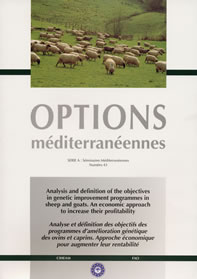| Article précédent | p. 47-59 | Article suivant |
Breeding objectives of Hungarian dairy sheep breeds
In the Hungarian sheep industry there are about 60,000 head of sheep milked in a total of one million ewes in 1999. A large part of the milked ewes are Merinos, while the others are partly purebred and partly crossbred milk type sheep as follows: Awassi, Lacaune, British Milksheep, Cigája, Trans-Sylvanian Raczka, (Merino x Pleven Blackhead) F1-Pleven F1-, Pleven F1 x Black East Friesian, (Merino x British Milksheep) F1, (Merino x Lacaune) F1, (Merino x Awassi) F1. During the last years breeding and production data on these genotypes were collected continuously, and added to the information about the production systems (size of land, labour, feeds and forages, prices of lambs, milk, wool and cheese, as well as the prices of different feeds. Data used in the evaluation were collected in seven farms between 1997-1999. Since the three production systems (extensive, semi-intensive and intensive) are practised in the country, the evaluations were carried out according to the breed-genotype and the production system. Along with the average reproduction and production results, economic data were calculated referring to one single ewe, one labour unit, one Ha, and one unit of feed. Different calculations were made to find out the possible correlations between the studied traits.
- [ Afficher ]
- [ Télécharger ]
- [ Exporter la citation ]
Vous pouvez télécharger la citation au format :
- [ Imprimer ]
-
Mots-clés
GENOTYPE, OVIN, PRODUCTION ANIMALE, VALEUR ECONOMIQUECiter cet article
Kukovics S., Jávor A., Sáfar L. Breeding objectives of Hungarian dairy sheep breeds. In : Gabiña D. (ed.). Analysis and definition of the objectives in genetic improvement programmes in sheep and goats. An economic approach to increase their profitability . Zaragoza : CIHEAM, 2000. p. 47-59. (Options Méditerranéennes : Série A. Séminaires Méditerranéens; n. 43). Meeting of the Sub-Network on Genetic Resources of the FAO-CIHEAM Inter-Regional Cooperative Research and Development Network on Sheep and Goats, 1999/11/18-20, Zaragoza (Spain). http://om.ciheam.org/om/pdf/a43/00600467.pdf



